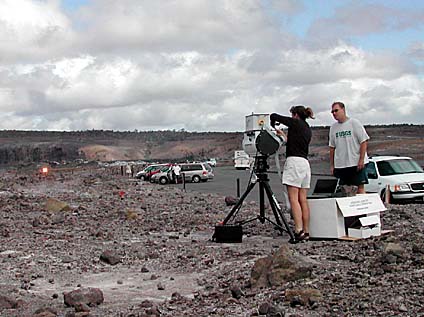
PHOTO COURTESY OF MARIE EDMONDS
Geologist Marie Edmonds sets up an infrared spectrometer to measure gases in the air at Kilauea Volcano with the help of the "glower" shining in the distance. Looking on is geologist Peter Cervelli, of the Hawaiian Volcano Observatory, where Edmonds is a visiting scientist.
Kilauea gas might
aid eruption forecastA British scientist uses a safer,
smarter way to assess the volcano
HILO >> It's a beautiful day at Kilauea Volcano, and the air is laced with sulfuric acid formed as gases pour out of the ground, then drift as far as Honolulu in the form of vog.
To study the gases, scientists periodically stick a tube into a volcanic vent. "They have to put their life at risk to go and collect them," said University of Hawaii geochemist Don Thomas.
Now British geologist Marie Edmonds has come to the Hawaiian Volcano Observatory with a new way to study volcanic gases, reducing the danger while gathering much more information.
The process is called "open-path," meaning outdoors, "Fourier transform," meaning some math is involved, "infrared spectroscopy," meaning examining invisible light.
The only volcanoes in the world where it is used routinely are Mount Etna in Italy and Soufriere Hills in the Caribbean, both places where Edmonds has worked before.
Now Edmonds, 28, the holder of a doctorate in volcanology from Cambridge University, has received a U.S. government Mendenhall Postdoctoral Fellowship to work at the Hawaiian Volcano Observatory. Normally, the fellowship is only open to U.S. citizens, but Edmonds' skills are so rare that an exception was made.
"We're lucky to have her," said observatory colleague Peter Cervelli.
Geologists have been using spectroscopy on gases, splitting light into different colors, for a long time. Thomas used an infrared spectrometer at Kilauea during his student days in the 1960s.
But they generally used ultraviolet light instruments that were big, heavy and expensive, and that limited them primarily to studying sulfur dioxide, the stuff that forms sulfuric acid.
Edmonds' infrared instrument is also big and expensive, costing about $100,000, but it lets Edmonds analyze up to eight different chemicals at once. The data can be radioed back to a laboratory in a continuous stream that can give minute-by-minute information on what an eruption is doing.
Combined with other data, such as earth tremors and ground deformation, the result could be prediction of eruptions. "Prediction is what we're all aiming for," Edmonds said.
When Mount Pinatubo in the Philippines blew in 1991, gas data was "a key part of the puzzle" that allowed scientists to warn that trouble was coming within a few hours, Thomas said.
Making this possible is an "explosion" in technology, Edmonds said.
University of Hawaii geologist Keith Horton has five "fly spec" (flyweight spectrometer) ultraviolet instruments at the volcano observatory, each weighing a tenth as much as older instruments.
Edmonds' infrared instrument is still at the bulky stage. To operate properly, it needs a miniature refrigerator inside, she explained.
